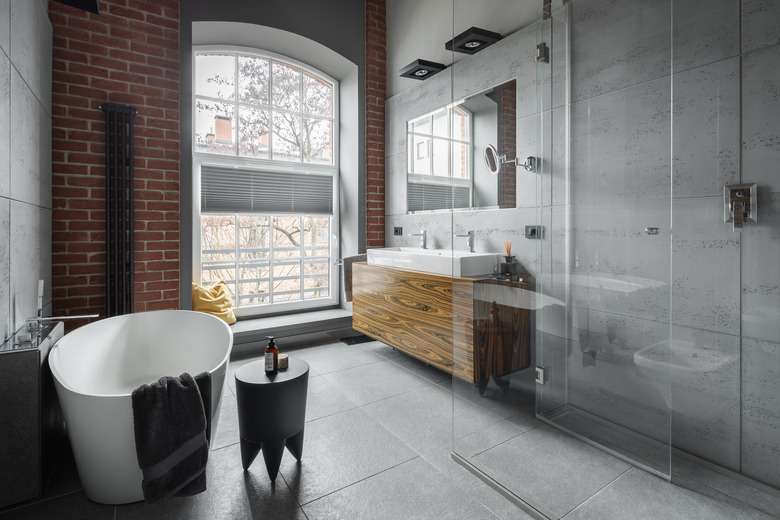How Make Paint Stick To Concrete Shower Floor
We may receive a commission on purchases made from links.
A concrete shower floor can be a very practical material, as it's very durable when finished properly. However, over time, concrete can be prone to staining and marking. Concrete shower floors can also look rather industrial and not particularly inviting. Painting a concrete shower floor can give it a fresh new look and help to protect it. Following the correct prep and painting steps is key to achieving a functional and aesthetically appealing finish.
Prepping Your Shower Floor
Prepping Your Shower Floor
The first step to painting a concrete floor is ensuring it's as smooth as possible. Look over the flooring for any larger dips or cracks and fill them in with mortar. Make sure the mortar is fully dry, then put on a protective mask smooth out the concrete using a wire brush or heavy-grit sandpaper to make it as uniform as possible. Vacuum the area to remove any traces of dust.
You'll then need to thoroughly clean the concrete. Mop the shower floor with a floor cleaner to remove any dirt. You should then clean the floor with 1/2 cup of trisodium phosphate (TSP), dissolved in 2 gallons of hot water, which helps to remove any grease or oil that could prevent your paint from sticking. However, it's a caustic substance and needs to be used with care. Make sure you wear a long-sleeved shirt, rubber gloves, and goggles and ensure the room is well-ventilated.
You should also prep your shower floor for painting by protecting the edges of your floor and any metal components. Cover any areas you don't want to paint with masking tape.
Painting Your Shower Floor
Painting Your Shower Floor
There are several different options for concrete paint. You must choose one that contains binders that expand on the concrete's surface; otherwise, the concrete will simply absorb the moisture. Shower floors also require durable, waterproof paint, or they will quickly start to look old and worn.
You'll again need to ensure you're taking adequate safety precautions. Make sure the room is well-ventilated, and wear the same rubber gloves and goggles, alongside a respirator mask designed for paint vapors. A dust mask will not suffice in this instance.
It's usually a good idea to first prime your concrete floor with an epoxy paint primer using a roller. Start from the center of your shower floor and work outward. Leave the primer adequate time to dry according to the product instructions.
Once your primer is dry, you can begin painting. An epoxy floor paint is the best option for a concrete shower floor, as it's durable against both foot traffic and water. Use the same roller and the same center-outward technique. Again, leave adequate drying time. It's recommended you give your shower several days to dry before using it again.
Painting Shower Floor: Final Steps
Painting Shower Floor: Final Steps
Remove the masking tape from the perimeter of your shower floor using a utility knife. This is quicker and more effective than simply pulling it free — plus, it prevents any paint from being accidentally lifted away from your floor.
You can use a sealant to finish your concrete shower floor painting. Epoxy paint is self-sealing but adding an extra layer can help with extra longevity. It can also give the floor a more lustrous color.
A freshly painted shower floor should not necessarily be any more slippery than it was before painting. However, if you're concerned about slips and falls, you can purchase anti-slip sprays or even a special shower mat to add grip.
Painted Shower Floor: Ongoing Maintenance
Painted Shower Floor: Ongoing Maintenance
To help keep your painted shower floor looking its best, you'll want to minimize humidity in your shower. Make sure you ventilate the room and dry the concrete floor after use. Ensuring you keep your shower clean and free of any soap scum or mineral buildup can also help your painted concrete floor last.
